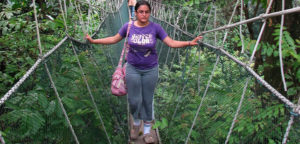With an entire area of 970 square kilometres and located 225 Km from Kigali, Nyungwe Forest National Park is 90 Km from Butare and 54 Km from Cyangugu was gazetted as a national park in 2004. Nyungwe forest has an elevation range of between 1600 M-2950 M above sea level with temperatures changing between 0°C and 30° C; average day temperatures 15°C whereas rainfall is between 1800-2500 mm per year. The rainy season is from September to May and dry season from June to August with some dry weeks in December and January.
Attractions in Nyungwe Forest National Park

- Over 100 species of orchids and giant lobelias.
- Largest montane rain forest remaining in Africa.
- Mt. Bigugu (2925M)
- Kamiranzovu marsh (13 sq. Km)
- In the vicinity Cyamudongo community forest with resident population of Chimpanzees.
- 260 species of trees and shrubs.
- Over 275 species of birds recorded including the Ruwenzori turaco, Ross's turaco, Grey –cheeked hornbill, Red-throated alethe, Red-breasted sparrow hawk, White-headed wood-hoopoe, Kungwe apalis, Ruwenzori batis, Blue-headed and Regal sunbirds.
Recorded species of primates at Nyungwe - 25% of all primates in Africa:
- Chimpanzees
- Grey-cheeked mangabey
- Olive baboon
- Red -tailed monkey
- Silver monkey
- Ruwenzori colobus
- L'Hoest's monkey
- Vervet monkey
- Golden monkey
- Owl-faced monkey
- Den't mona monkey
- Three species of bush baby.
Other animals comprise of the leopard, golden cat, serval cat, side-stripped jackal, Genet, African civet, slender and the marsh mongoose which represent the carnivores. There are also three species of duikers, two species of flying squirrels, tree hyrax, and Congo clawless otter. There are over 120 species of butterflies and reptiles including three species of horned chameleons that have been recorded.
Tour Activities - Nyungwe forest National Park
Any visitor is at liberty to undertake activities within and in the surrounding areas of Nyungwe Forest National Park which include:
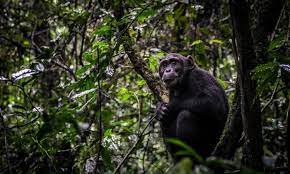
- Primate trekking like the chimpanzees and visitors have to book for chimpanzee tracking in advance.
- Bird walks.
- Excursions to Kamiranzovu Marsh.
- Excursions to Lake Kivu and Gisakura tea factory.
- Scaling Mt Bigugu (2925M).
- Photography.
As you are going to Nyungwe, you can stop for a moment at:
- Genocide memorial of Murambi.
- Butare –visit the Museum, University, cathedral, arboretum and the curio worships.
- Nyabisindu to visit the Nyanza King's Palace, the capital of ancient Rwanda Kingdom.
- The Cathedral of Kabgayi and the adjacent small ethnographic museum. Kamageri's Rock (Uratare rwa Kamageri) on the roadside after Ruhango towards Gikongoro.
Accommodation
Nyungwe Forest Lodge is an eco-lodge located in the tea estate overlooking Nyungwe forest. The lodge has wifi internet, TV, health club. You can also stay at Uwinka Rest House, Gisakura Guest House, ORTPN campsites.
Visiting the primates can be done basing at Gisakura ORTPN headquarters and at Uwinka Tourist Centre. Nyungwe forest national park offers a wide range of accommodations from budget to luxury including Kitabi Eco campsite, Gisakura Guest House, One & Only Treehouse.
More about Nyungwe national park

Nyungwe national park is 189 km (5-hour drive) south west of Kigali capital city via Kitabi eastern entrance gate. The destination can also be reached by air through Kamembe airport in Ruzizi town near DR Congo border. Kamembe is 66 km from the western entrance gate at Gisakura. Those traveling from Volcanoes national park or Gisenyi town can reach the park via Ruhengeri-Gisenyi road.
Situated within the Albertine rift valley along the Congo Nile divide, Nyungwe is ideal for birding and primate tracking. The protected area covers 1,002 sg.km with altitude ranging from 1,600 m to 2,950 m above sea level. Nyungwe is a tropical evergreen montane forest with a variety of vegetation types including dense primary and secondary growth forests, lowland swamps, and bamboo.
Due to the variety of habitats Nyungwe is rich in biodiversity including 13 primate species, 348 bird species, 120 butterfly species, over 30 reptile species, 96 mammal species, and 1,100 plant species with over 250 tree species, and 140 orchids of which some are Albertine rift endemics. The park is most important for conservation of the eastern chimpanzees, which are the main attractions. In addition to chimpanzee tracking, Nyungwe also offers a canopy walk, Rwenzori colobus monkey tracking, and 13 nature trails for hiking and bird watching.
Visitors can also explore the adjacent local communities including Gisakura tea plantation tours and Nyungwe cultural village. The Rwanda Development Board (RDB) in 2020 formed a renewable long term partnership with the African Parks Network in order to improve law enforcement and conservation as well as provide world class tourism services. Booking a safari to Nyungwe forest can be done through RDB or a tour operator.
Nyungwe visitor centers
Nyungwe forest has 3 visitor centers which include Uwinka, the park headquarters in the center of the forest, Gisakura to the west, and Kitabi in the west. Gisakura center is 179 km (2-hour drive) south of Gisenyi town and 227 km (4-hour drive) from Volcanoes national park. Chimpanzee tracking can start at any of the centers depending on the location of the primates on the D-day. Therefore, visitors must need to obtain information beforehand to be at the right place at the time. The canopy walk and most of the hiking starts from Uwinka.
Vegetation
Nyungwe is a montane tropical forest with 1,100 plant species including over 250 tree and 140 orchid species. The vegetation forest is made up of both primary and secondary growth and is also influenced by altitude and nature of soils. For instance, the western section of Nyungwe contains schists, which are metamorphic crystalline rocks that contain heat retaining minerals such as quartz and mica making them unsuitable for cultivation.
The areas around Gisakura and Uwinka visitor centers remained untouched and contain mature and primary dense forest. Deciduous tree species with flat-topped crowns and wide-spreading branches that can grow from up to 40 meters tall dominate the lowland areas in western parts of Nyungwe.
Tree species in the genus Entandophragma such as tiama Mahogany, the East African camphorwood (Ocotea usambarensis), star apple (Chrysophyllum), newtonia buchananii, water pea (syzygium guineense), guinea plum tree (Parinari excelsa), Carapa procera (c.grandiflora), Tarairi (Beilschmiedia tarairi), Black chokeberry (Leptonychia melanocarpa), and Strombosia ceylanica.
These species provide hardwood timber and the logging activity led to fragmentation in which Cyamudongo forest was eventually disconnected from the larger Nyungwe. Covering 410 hectares, Cyamudongo contains unique species of flora and fauna including Ross’s turaco and the red legged sparrowhawk, which are rare to see in other parts of Nyungwe. Tree species in Cyamudongo forest include rushfoil (croton spp), Leptonychia melanocarpa, Fluted milkwood (Chrysophyllum gorungosanum), and Alangium chinense.
The eastern side is partly characterized by secondary growth forest due the historical encroachment. Tree species in this area are of the Euphorbiaceae family such as African redwood (hagenia), Wild berries (Maesa), and the dragon’s blood tree (Harungana).
Bamboo
Mount Bigugu (2,950 m) north of Uwinka marks the highest altitude of Nyungwe forest. Other hilly areas of the park include Ruhindu (2,890m) to the north east and Ngabwe (2,750m) to the south-east. Due to the rocky soils, the vegetation cover is characterized by mountain bamboo (Arundinaria alpina) and tropical subalpine shrubs such as Erica kingaensis and Philippia benguellensis (spiderwort).
Swamps in Nyungwe forest
Nyungwe forest also contains three swamps including Kamiranzovu in the west, Uwasenkoko and Mubuga in the east. Kamiranzovu swamp is the largest and accessible by a 5.9 km nature trail from Uwinka visitor center. The swamp is created by a tributary of the Nile river with waterfalls, which Rwanda claims to be the furthest source of the Nile river. Visiting Kamiranzovu swamp offers a chance to spot the Congo Clawless Otter (Aonyx congca), which is near threatened on the IUCN red list.
Fauna
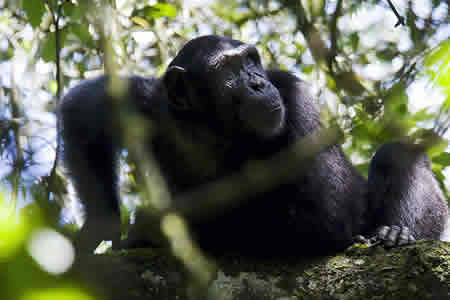
The 12 primate species in Nyungwe forest national park include chimpanzees, black and white colobus monkeys, L’hoest monkeys, blue monkeys, gray cheeked mangabeys, dwarf galago, velvet monkeys, olive baboons, red tailed monkeys, ow-faced monkey, greater bushbaby, and dent’s mona monkeys. Besides the primates, there are 96 mammal species including the black fronted, lestrade’s, and yellow backed duikers, bush pigs, giant forest hogs. Big and small nocturnal carnivores recorded in Nyungwe forest include leopard, the cape and zanzibar servaline genets, the African and two spotted palm civets, and the African golden and serval cats.
What to do in Nyungwe forest
Nyungwe forest national park offers a wide range of things to do including chimpanzee and colobus monkey tracking, canopy walk, hiking, birding, and tea plantation tours.
Chimpanzee tracking
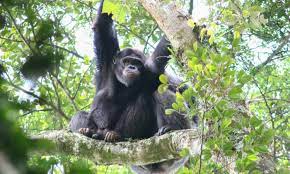
Any of the three visitor centers in Nyungwe can serve as the starting point for chimpanzee tracking. Based on the location of your lodge, expect to begin your day early in the morning for a timely transfer to the relevant center. Briefing on chimp tracking usually starts at 7:30 am or 8:00 am with the RDB rangers giving precise instructions.
For instance, hiking on foot in search of primates can be challenging due to the nature of terrain. Chimps are highly active creatures and can move up to 5 km during the day depending on food availability in any given home range. Therefore, the time it takes to find them can range from 1 hour to 5 hours with longer or shorter treks expected. You never know how long you will be in the forest.
In that regard, you’re advised to hire a porter, take a packed lunch, and at least 2 liters of drinking water. Those who may not be able to complete their trek can be carried on a sedan chair to and from the forest. The extra cost is $300 per person. After the briefing, visitors will be taken to the actual tracking locations, which include the Cyamudongo forest. Situated in the western section of Nyungwe, Cyamudongo covers 410 hectares.
Though part of Nyungwe national park, it remains a very isolated and unique forest with species that are hard to find in the larger Nyungwe including Ross’s turaco and the red legged sparrowhawk (accipiter erythropus). Tracking can be done in other parts of Nyungwe. The chimpanzee tracking permit cost is $150 per person available for booking through RDB or a tour operator.
Canopy walk
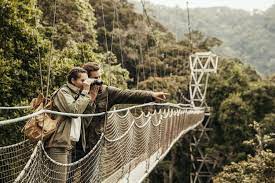
The Nyungwe forest canopy towers 70 meters above the ground, providing stunning views of the forest. There are three walkway sections including the 25, 50, and 90 meters long. You can choose any of your choice and the cost is the same for all. The canopy walk cost is $80 for two people. One person will pay the same amount.
Colobus monkey tracking
Another fascinating primate activity in Nyungwe is Colobus monkey tracking. Nyungwe forest is famous for harboring one of the high populations of black and white colobus monkeys in East Africa. In particular, there’s a single troop of over 400 colonus monkeys which is habituated for visiting. Given that the colobus monkeys prefer to hang out in secondary growth and open forest areas, they’re simpler to find and see without having to trek deeper into the forest. The activity starts at Uwinka visitor center available for two sessions with one in the morning at 8:00 am and afternoon session at 2:00pm.
Tea plantations
Nyungwe forest is surrounded by tea plantations including the Gisakura estates which offer an opportunity to discover how tea is made from garden to cup. A tea plantation tour can be done through village walks, biking, or scenic drives. Those intending to understand and experience the village life up close can visit Nyungwe cultural village in Banda, which is 9 km from Gisakura visitor center.
The best time of year to visit Nyungwe forest
Those intending to do chimpanzee trekking or hiking the best time to visit is during the dry season. From June to September and December to February the weather is hot and dry. Given that there’s little rainfall, the forest floor is relatively drier and hiking becomes easier. However, the dry season may affect the foliage and the feeding patterns of primates. For instance, the chimps tend to move longer distances than expected as they spend most of their day in the moist parts of the forest with fresh foliage. Therefore, hiking to find them may entail longer treks, which can be challenging due to the nature of terrain. During the dry season in Nyungwe, the average temperature ranges from 19.6 °C - 20°C and drops to 11°C or 10 °C at night.
Nyungwe can also be visited any time of the year and during the rainy season. October to November are the wettest and short rains occur from March to April ending in May.
Humidity can be as high as 88% and the rainfall of up 1,500 to 2,000 mm per annum. The forest floor is wetter and the nature trails are muddy and slippery. Those intending to visit need to pack rain jackets and gaiters for extra leg protection. The advantage of visiting Nyungwe in the rainy season is that the chances for shorter treks is higher. Given that there’s abundant foliage, the chimps tend to remain in one area, making them easier to find. Even though the dry season is the best time, Nyungwe can be visited anytime of the year and the rain can fall at any time of the year.
